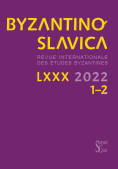Revisiting the Rus Visitors to Louis the Pious
Revisiting the Rus Visitors to Louis the Pious
Author(s): Jonathan ShepardSubject(s): History, Language and Literature Studies, Archaeology, Cultural history, Studies of Literature, 6th to 12th Centuries, Geopolitics
Published by: AV ČR - Akademie věd České republiky - Slovanský ústav and Euroslavica
Keywords: material evidence ;secondary literature ;Byzantine ;emperor Theophilos ;longstanding Byzantine alertness ;Louis the Pious ;Theophilos ;Annales Bertiniani ;
Summary/Abstract: In 1995 I suggested that a pattern of material evidence might relate to a group of visitors to, successively, the courts of the Byzantine emperor Theophilos (827–842) and his western counterpart, Louis the Pious (812–840). This article revisits the suggestion in light of material evidence and secondary literature published since which bear, directly or indirectly, on the visits paid by the Rhos to Louis at Ingelheim and, some three years later, by Theodosios Baboutzikos to Lothar at Trier. Without fully engaging with the burgeoning secondary literature or every item of material data of conceivable relevance, I discuss archaeological, numismatic and sigillographic finds relevant to the original report in the Annales Bertiniani from three areas where fresh archaeological data is in play: Riurikovo Gorodishche, Gnezdovo and the Baltic Rim (with particular reference to Birka, the Jutland peninsula and Zealand). Account is also taken of a couple of broader considerations offering the historical background to the finds. The first encompasses the ups and downs of Theophilos’ reign: his ambitiousness for victories at the expense of the Abbasids, meeting with disaster and humiliation at the hands of Caliph Al-Mu’tassim in 838, and his subsequent diplomatic, naval and military demarches in order to regain ‘ face’. The second historical point is broader still: the longstanding Byzantine alertness to distant sources of high-calibre military manpower and corresponding interest in the topography and communications of faraway regions. The Byzantines’ interest in northwest Europe is attested for the later sixth century, where literary evidence converges with that of artefacts from such sites as Prittlewell and Sutton Hoo. A similar alignment of Byzantine artefacts and literary evidence may yield comparable results, signalling a flurry of diplomatic overtures and Theophilos’ recruitment efforts over a short period, from c. 835 to 842.
Journal: Byzantinoslavica - Revue internationale des Etudes Byzantines
- Issue Year: LXXX/2022
- Issue No: 1-2
- Page Range: 59-87
- Page Count: 29
- Language: English
- Content File-PDF

